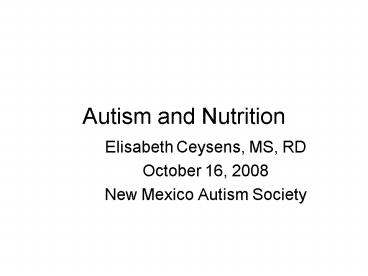Autism and Nutrition - PowerPoint PPT Presentation
1 / 22
Title:
Autism and Nutrition
Description:
Conclusion: selective food preferences and dairy-free diets put children at risk ... recent reports of altered FA metabolism in boys with ADHD ... – PowerPoint PPT presentation
Number of Views:959
Avg rating:5.0/5.0
Title: Autism and Nutrition
1
Autism and Nutrition
- Elisabeth Ceysens, MS, RD
- October 16, 2008
- New Mexico Autism Society
2
Common Nutrition and Feeding Concerns
- Picky eating behaviors
- Difficulty with transitioning to age-appropriate
diet - Increased sensory sensitivity
- Short attention span
- Limited variety in diet
- Need for routine
3
Eating Preferences
- Preference for dry, crunchy foods
- Refusal of soft, smooth textures
- Dislike of fruits and vegetables
- Preference for finger foods
- Preference for certain brands and preparation
methods - Preference for food of particular color(s)
4
Preferred Foods
- dry cereal
- crackers
- chicken nuggets
- pizza
- bread
- hot dogs
- pasta
5
What about Growth?
- The majority of children with ASD are of average
height and weight
6
Bone Health
- A study of 75 boys with autism ages 4 to 8 showed
that the bones of the boys with autism was
significantly thinner than bones of boys of the
same age without autism. - Conclusion selective food preferences and
dairy-free diets put children at risk for calcium
and vitamin D deficiencies.
J. Autism Dev Disord (2008) 38848-856
7
Other Nutrition Concerns
- Vitamin and mineral deficiencies
- Gastrointestinal concerns (reflux, constipation,
diarrhea) - Drug-nutrient interactions
- Food allergies and Celiac disease
- Alternative therapies (CAM)
8
Drug-nutrient Interactions
- Medications may increase or decrease appetite and
may affect vitamin/mineral absorption - Ritalin decreases appetite and stunts growth
- Risperdal, a SSRI, may increase appetite
- Seizure meds affect calcium, vitamin D and folate
metabolism and may need to be supplemented
9
Diet Adequacy What Do We Know?
- Some studies show no difference in nutrient
intake with typically developing children. - Other studies show children with ASD eat less
than the recommended amounts of vitamins C, D,
several B vitamins, iron and calcium. - A 2008 study showed lower intake of vitamin A
and calcium than controls.
J Amer Dietetic Assoc (2008) 1081360-1363
10
Alternative Therapies
- No evidence-based research to show effectiveness
of alternative treatments - Select alternative therapy with caution and be
aware of possible toxicity
- Vitamin B6 and magnesium supplement
- DMG
- Antioxidants
- Zinc
- Coenzyme Q10
- Beta Glucan
11
Gluten-Free, Casein-Free Diet
- Leaky gut hypothesis the gut allows peptide
metabolites of casein and gluten to cross into
the blood and then into the spinal fluid. - These peptides act as opiates in the brain and
interfere with CNS function. - The implication is that this causes autism.
12
GFCF Diet Studies
- A meta analysis in 2004 showed no evidence for
efficacy of GFDF diet. - A 2006 preliminary study of 15 children with
autism, ages 2-16 years, showed no significant
results although parents reported improvement of
autism symptoms. This study shows how a clinical
trial can be conducted.
J of Autism and Dev Disord (2006) 36413-420
13
GFCF diet Impact on Families
- Extra time needed to buy and prepare foods/meals
- Diet makes child special or different
- Diet makes peer/social interactions more
difficult - High cost of alternative foods
14
GFCF Diet Nutrition Implications
- Children on the GFCF diet eat more fruits and
vegetables and less bread and cereals - Risk of nutrient deficiencies
- Gluten-free diet Iron, zinc, B vitamins and
folate - Diary-free diet Calcium, vitamin D,
vitamin B2 and protein
15
(No Transcript)
16
GFCF DietWhat to Do?
- Weigh the pros and cons and decide if the diet
may be an option for your child. - Start slowly. Start with CF or GF diet first,
making a few changes at a time watch your
child! - Supplement calcium and vitamin D.
- Give a childrens multivitamin with minerals.
- Talk to your pediatrician.
- Consider consultation with a registered dietitian.
17
GF Diet Websites
- www.gfco.org
- www.gluten.net
- www.livingwithout.com
- www.glutenfreepantry.com
- www.allergygrocer.com
- www.foodallergynetwork.com
- www.missroben.com
18
Supplements to ConsiderProbiotics
- Probiotics are live microorganisms (bacteria)
that have beneficial effect on the gut flora. - No link between probiotics and autism symptoms
- Used for general gastrointestinal health.
- Each probiotic strain has a different mechanism
of action and different effect on the body.
19
Supplements to ConsiderOmega-3 Fatty Acids
- Omega-3 Fatty Acids
- inhibit the bodys inflammatory response
- may help reduce childhood asthma, heart disease
and rheumatoid arthritis - important in infant brain development
- recent reports of altered FA metabolism in boys
with ADHD - Found in fatty fish, walnuts, flax seeds,
soybeans, canola and flaxseed oils
20
Omega-3 Fatty Acids Recommended Amounts DHA/EPA
Combined
- 1-3 years 700 mg
- 4-8 years 900 mg
- 9-13 years 1200 mg
- 14-18 years 1600 mg
- Adults 1600 mg
- Note Maximum amount for adults is 3000 mg or
- 3 grams per day.
Food and Nutrition Board, Institute of
Medicine, Adequate Amounts (AI), 2002.
21
Elisabeth Ceysens, MS, RDVoice Mail
272-0285email eceysens_at_salud.unm.eduAddress
Center For Development and Disability 2300
Menaul Blvd, SE, Suite 201C Albuquerque NM 87107
22
Questions ?































